Read Reviews
The Best Sun Shade Sails
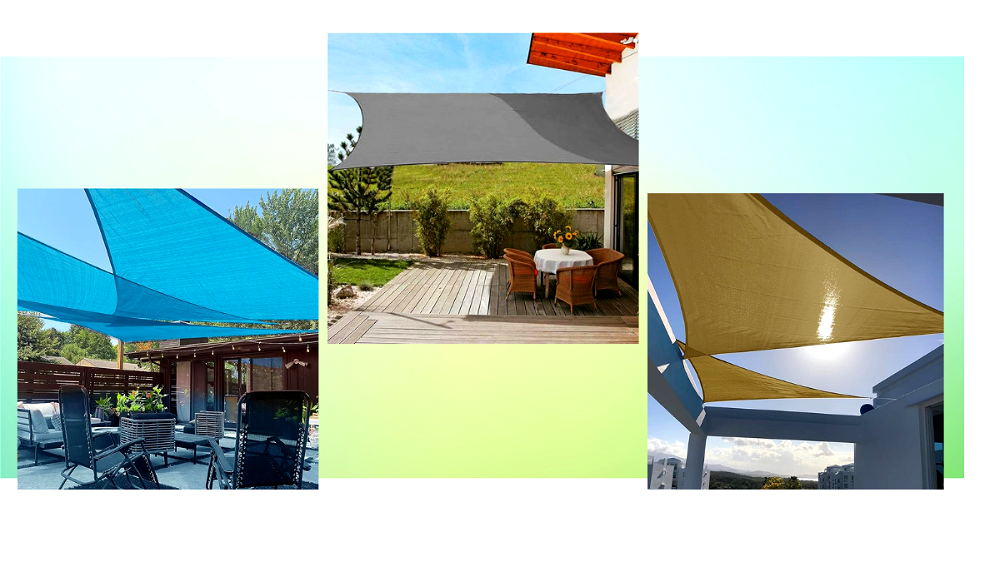
-
Best waterproof sun shade - OldPAPA Rectangle Sun Shade Sail
-
Best for choice of size and colour - LOVE STORY Triangle Sun Shade Sail
-
Best for durability - Belle Dura Rectangle Sun Shade Sail
-
Best for small gardens - AXT SHADE Recentagle Sun Shade Sail
-
Best for large gardens - AXT SHADE Triangle Sun Shade Sail
-
Best for medium gardens - SUNNY GUARD Triangle Sun Shade Sail
-
Best for light rain - Ankuka Rectangle Sun Shade Sail
Sun Shade Sail Reviews
1. OldPAPA Rectangle Sun Shade Sail
Best waterproof sun shade
- Offers protecting from both the rain and sun
- Can also be used to protect garden furniture among other functions
- Protects against 95% of UV rays
- Six colour choices and three size choices
- Durable and tear-resistant fabric to last well over time
- Rope isn’t as durable as the sail
- Can be prone to stretching in heavy rain
- Seams can pose weaker points that can let water through
- Shape
- Rectangle
- Material
- Oxford polyester fabric
- No. of Colours
- 6
- No. of Sizes
- 3
- Waterproof?
- Yes
- UV Protection?
- Yes
- Design
- 5
- Weatherproofing
- 5
- Options
- 3.5
- Value for Money
- 5
The OldPAPA Rectangle Sun Shade Sail is one of the best waterproof shade sails available. It’s made from 160 gsm waterproof Oxford polyester fabric.
As well as protecting you from the rain, this shade protects against up to 95% of UV rays. The fabric is highly durable and tear-resistant, so it will last well over time. The metal D-rings are sturdy and the stitching is high-quality.
You can choose from six colours to suit your taste, including some nice bright options. There are three sizes to choose from so you can find something that works for the size of your garden.
This shade is rectangular and there are four ropes provided to help with installation.
However, despite being waterproof, there are seams on the sail that can let some water through. It’s also necessary to hang it at an angle, to help avoid water pooling on the top.
Even so, given this shade’s waterproof properties, it has the potential to be more versatile overall, given that it’s capable of protecting from both rain and sun. For this reason, it could be useful for protecting garden furniture or taking on camping trips. The price is very reasonable, so considering the material quality and multiple functions, this sail offers good value for money.
This sun sail is a fantastic choice with a high UV protection rating. It’s waterproof, durable, and even comes in a range of stylish colours.
Did you find this review helpful?
2. LOVE STORY Triangle Sun Shade Sail
Best for choice of size and colour
- Plenty of choices including size, shape, and colour
- Blocks up to 95% of UV rays
- Durable fabric and construction lasts well even when left out
- 1.5 m (5 ft) ropes provided for easy installation
- Holds up well against wind
- Can be prone to sagging or stretching in heavy rain
- Shape
- Several choices
- Material
- Polyethylene
- No. of Colours
- 19
- No. of Sizes
- 27
- Waterproof?
- No
- UV Protection?
- Yes
- Design
- 5
- Weatherproofing
- 4.5
- Options
- 5
- Value for Money
- 5
The LOVE STORY Triangle Sun Shade Sail is one of the best options if you want a protective shade that you can customise to suit your space. You can choose between either a triangular or rectangular shade sail, and there are 27 sizes and 19 colours to choose from. There are options to suit small to large gardens.
But It’s not just about choice. This shade is also durable and offers good sun cover. It’s made from 185 gsm high-density polyethylene fabric. The colours don’t fade easily, even when exposed to plenty of sun. Also, the stitching is strong and reinforced in several places to create a hard-wearing shade. It comes with rust-resistant stainless-steel D-rings in each corner to help with installation.
This shade sail protects against up to 95% of UV rays. As a result, it’s a great addition to the garden in summer. It’s important to note that this shade is breathable and it’s not designed to be waterproof. It does, however, cope reasonably well in mildly windy weather because of this.
1.5 m (5 ft) ropes are provided for attaching each corner of the sail. The manufacturer advises leaving around 45 – 60 cm of space between the fixing point and the shade. This ensures the shade sail hangs correctly and isn’t pulled too tightly. Although the shade doesn’t stretch, it’s durable enough to be pulled to create a taut cover.
The edges of the sail are curved, which helps to prevent drooping and increases the strength of the sail when it’s installed. If you want to install the shade more securely, a fixing kit is available to buy separately, but this is not included.
The available colours range from contemporary white, to dynamic deckchair stripes. Therefore, there are a lot of options to complement different gardens and preferences.
Overall, if you’re looking for the best sun sail, this is a great option to consider. Not only are there multiple sizes, shapes, and colours, it also provides a high-level of UV protection and is durable too.
Did you find this review helpful?
3. Belle Dura Rectangle Sun Shade Sail
Best for durability
- Made from high density polyethylene which is highly durable
- Double layer webbing makes the shade stronger
- Reinforced, double-layered edges to enhance strength and reduce the risk of tears
- Robust stainless steel D-rings for secure installation
- Blocks up to 98% of UV rays
- Assembly instructions need to be followed carefully to ensure it’s possible to get the shade taut
- Not waterproof so rain will get through
- Shape
- Rectangle
- Material
- Polyethylene
- No. of Colours
- 2
- No. of Sizes
- 1
- Waterproof?
- No
- UV Protection?
- Yes
- Design
- 5
- Weatherproofing
- 4
- Options
- 3
- Value for Money
- 4.5
The Belle Dura Rectangle Sun Shade Sail is an excellent option if you want the best sun sail for durability. It’s made from 185 gsm high-density polyethylene which has a medium-weight feel.
Once up, this sun shade blocks up to 98% of the sun’s UV rays, making it one of the best options for sun protection. Like many of the sun shades on this list, it isn’t waterproof. Instead, it’s breathable to allow rain and the breeze through, which helps to keep you cool.
To increase durability, this shade sail features double-layered webbing in the corners around the D-rings, and reinforced edges to increase strength.
Each corner is equipped with stainless steel D-rings to make the sail easier to install. Although it’s relatively easy to put up overall, the instructions need to be followed carefully to make sure it stays taut. There needs to be an imaginary straight line running from adjacent mount points corners.
Like most of the other shades on this list, this shade has curved edges. This helps to prevent drooping and increases the pull strength, for a more sturdy installation. The shade comes in a carry bag with handles, which is convenient for storage when the shade isn’t in use in the colder months.
This shade is rectangular and measures 3 x 4 m (10 x 13 ft). It’s a good size for small and medium gardens. There are two colours available: silver and rust red. The latter is brick coloured and can tone in well with different gardens.
Overall, this shade sail is an excellent choice for durability, made with durable high-density polyethylene, with double layers and reinforced edges. The high level of UV protection and breathability make it ideal to protect you from the sun.
Did you find this review helpful?
4. AXT SHADE Recentagle Sun Shade Sail
Best for small gardens
- Plenty of colour and size choices to suit your preferences
- Small size available which is ideal for smaller gardens/patios
- 95% UV protection
- Breathable fabric to allow light and air to pass through
- Not waterproof or designed to be used in heavy rain
- Can be prone to sagging if left up when raining
- Shape
- Rectangle
- Material
- Polyethylene
- No. of Colours
- 7
- No. of Sizes
- 6
- Waterproof?
- No
- UV Protection?
- Yes
- Design
- 4.5
- Weatherproofing
- 4
- Options
- 4
- Value for Money
- 4.5
If you have a small garden, the AXT SHADE Rectangle Sun Shade Sail could be the best shade sail for you. It comes in a range of six sizes, including one of the smallest sizes here: 2 x 3 m (6.5 x 9.10 ft). This is ideal for short gardens or small patio areas.
You can choose from seven colours, with suitable options available whether you want a pop of colour or more muted tones. Therefore, it’s suitable for a range of tastes. The shade sail is rectangular and comes with rope to attach it securely on all four corners.
Like most of the shade sails featured here, this option is made from 185 gsm high-density polyethylene. It’s capable of protecting from up to 95% of UV rays.
The fabric construction is breathable but not waterproof. This is useful for keeping air circulating on hot, stuffy days, but naturally it won’t offer protection from a shower. This shade sail isn’t recommended for use in heavy rain, and it may be prone to sagging in the middle when left out in these conditions.
It has a durable construction and comes with stainless steel D-rings on each corner. Although it stands up well to wind and general poor weather, it may start to sag after time and need re-tightening.
This is one of the best shade sails for small gardens because it’s available in a compact 2 x 3 m size. The material is durable, it comes in a choice of colours, and it offers a high level of protection.
Did you find this review helpful?
5. AXT SHADE Triangle Sun Shade Sail
Best for large gardens
- A range of colour and size choices to suit your taste
- Comes in one of the largest sizes here, suitable for large gardens
- High-quality, strong construction to stand up to wear
- 95% UV protection
- Comes with nylon rope for easy installation
- Not waterproof or designed to stand up to heavy rain
- Shape
- Triangle
- Material
- Polyethylene
- No. of Colours
- 6
- No. of Sizes
- 5
- Waterproof?
- No
- UV Protection?
- Yes
- Design
- 4.5
- Weatherproofing
- 4
- Options
- 4
- Value for Money
- 4.5
The AXT SHADE Triangle Sun Shade Sail is worth considering if you’re searching for the best shade sail for large gardens. This triangle shade is available in a choice of five sizes, including a large size that measures 6 m (20 ft) on each side. There’s also a choice of six colours.
Like most of the other shades featured here, it’s made from 185 gsm high-density polyethylene, designed to wear well over time. It stands up well to bad weather and can be installed in the corners of the garden as well as across the centre.
It offers 95% UV protection, providing good protection from the sun. The fabric is both breathable and permeable, which does mean this shade isn’t waterproof. Instead, the material allows some light and air through, to help keep you cool in hot weather.
A nylon rope is provided to attach to the stainless steel D-rings. Overall, this shade is reasonably easy to install. The curved edges are carefully calculated to help keep the sail tight once it’s installed.
If you want to have a large area of shade, this is an ideal shade to consider. It comes in a range of sizes, including one of the largest options here. It is durable and offers a good level of protection against UV rays. Other worthwhile factors include that it comes in a choice of colours and is breathable.
Did you find this review helpful?
6. SUNNY GUARD Triangle Sun Shade Sail
Best for medium gardens
- Ideal size for medium gardens or extra shade for smaller gardens
- Strong construction to ensure durability
- 95% UV protection and 85% shade rate for protection from the sun
- 1.5 m nylon ropes included for easy installation
- Choice of two stylish colours
- Not waterproof or designed to stay up in heavy rain
- Not as many colour choices as other options
- Shape
- Triangle
- Material
- Polyethylene
- No. of Colours
- 2
- No. of Sizes
- 1
- Waterproof?
- No
- UV Protection?
- Yes
- Design
- 4.5
- Weatherproofing
- 4
- Options
- 3
- Value for Money
- 4.5
The SUNNY GUARD Triangle Sun Shade Sail is ideal for medium/large gardens. It’s a triangular shape and each side measures 5 m (16.5ft). Like the majority of the shade sails here, it’s made from 185 gsm high-density polyethylene, making it durable, breathable, and practical.
This shade protects from up to 95% of UV rays meaning it can offer good protection from the sun. There are D-rings in each corner and nylon rope comes included as well. The rope provided is 1.5 m long, which is fairly standard, but it’s worth double checking it’s suitable for the area you want to shade before purchase. The sides of the shade are curved which helps prevent sagging in the middle.
The polyethylene material is breathable so it allows a breeze to flow through. Although, as with most of the options listed here, this means it isn’t waterproof. It’s best not to leave it out during heavy rain or extreme weather to avoid damage to the sail.
This sail comes in a choice of two colours, sand and charcoal, which are both muted and stylish. They’ll complement most garden colour schemes, but there’s not as much choice as with some other shades.
Aside from the lack of colour choice, this is a high-quality shade. It’s one of the best shade sails for medium to large gardens. It has a high protection rating, durable construction, and is designed to last.
Did you find this review helpful?
7. Ankuka Rectangle Sun Shade Sail[ SAVE 43% ]
Best for light rain
- 220 gsm high-density polyester, the highest density fabric here
- Water-resistant with a waterproof coating, ideal for light rain
- 98% UV protection
- Great value for money considering price and specification
- Plenty of colour and size choices to suit your needs
- Not fully waterproof and not suitable for heavy rain
- Seam down the middle is a little less aesthetically pleasing and can allow water through
- Shape
- Rectangle
- Material
- Polyethylene
- No. of Colours
- 12
- No. of Sizes
- 4
- Waterproof?
- Water resistant
- UV Protection?
- Yes
- Design
- 4.5
- Weatherproofing
- 4.5
- Options
- 4.5
- Value for Money
- 5
If you’d prefer a shade sail that can stand up to some light rain, the Ankuka Rectangle Sun Shade Sail is well worth considering. This sail has a waterproof coating that makes it water-resistant. It isn’t fully waterproof, but it is capable of providing some protection from light rain. This is pretty impressive, considering that it’s one of the best shade sails to buy on a budget as well.
When it comes to protection from the sun, this shade protects against 98% of UV rays. The fabric is 220 gsm high-density polyester, making it marginally heavier per metre squared than other shades on this list.
To add to the durability, there are three layers of webbing and stainless steel D-rings.
This shade is rectangular in shape. It comes in a choice of 12 colours, including some lovely bright colours that are perfect for summer. You can choose from four sizes to suit your garden. The 3 x 4 m shade is suitable for medium gardens, and is a very affordable price.
It comes with a bag to store it in when it’s not in use, which is handy. There are four ropes provided, although there’s no fixing kit so you will have to buy one if you prefer it to be more securely installed.
A downside to this shade is that it has a seam down the middle of the sail, which may be less aesthetically pleasing to some people.
Nevertheless, considering the price and all of the features it has to offer, it’s a good option to consider. It’s inexpensive, yet still offers up to 98% UV protection and a level of water resistance too.
Did you find this review helpful?
Compare Product Features
Use the dropdown to sort the table by the feature you want to see.
OldPAPA Rectangle Sun Shade Sail
- 4.6
- Rectangle
- Oxford polyester fabric
- 6
- 3
- Yes
- Yes
LOVE STORY Triangle Sun Shade Sail
- 4.9
- Several choices
- Polyethylene
- 19
- 27
- No
- Yes
Belle Dura Rectangle Sun Shade Sail
- 4.1
- Rectangle
- Polyethylene
- 2
- 1
- No
- Yes
AXT SHADE Recentagle Sun Shade Sail
- 4.3
- Rectangle
- Polyethylene
- 7
- 6
- No
- Yes
AXT SHADE Triangle Sun Shade Sail
- 4.3
- Triangle
- Polyethylene
- 6
- 5
- No
- Yes
SUNNY GUARD Triangle Sun Shade Sail
- 4
- Triangle
- Polyethylene
- 2
- 1
- No
- Yes
Ankuka Rectangle Sun Shade Sail
- 4.6
- Rectangle
- Polyethylene
- 12
- 4
- Water resistant
- Yes
How to Choose The Best Sun Shade Sail
Sun shade sails are a great way to help you and your family enjoy the summer sun safely. They create a cool shaded area to relax in and help to protect you from the sun’s harmful UV rays. Some will even offer shelter from the rain as well!
Below are some tips to guide you when choosing the best sun sail for your garden.
Size and Shape
One of the main things you want to look for when you’re on the hunt for the best sun sail shade is the size and the shape. They come in a range of sizes to suit small to large gardens. They also come in several shapes including triangles, rectangles, and squares.
As well as the size of your garden, think about the size of the specific area you want to cover. For example, if you just want to cover a small corner of your garden where a bench is or where your dog lies, then a smaller triangular shade will likely be suitable. If you want to cover a large area, such as an outdoor seating area or an area where kids play, then you’ll probably want a large rectangular shade.
When considering the shape and size, think about where you’re going to place the shade. A rectangle or square will need four stable anchor points, far enough apart so that the shade is taught. By contrast, a triangular shade will only need three anchor points, which may be more feasible in certain gardens.
READ NEXT: The Best Pop of Gazebos
Material Type and Quality
Shade sails typically come in durable, high-density material. Look for high quality material, such as the high-density polyethylene. You’ll notice that most of the shades on this list are made from polyethylene as it’s both durable and breathable.
The density of the fabric is often indicated in ‘gsm’. This stands for grams per square metre, giving an indication of the weight of the material. The higher the gsm number, the heavier and denser the fabric is. Usually, this is a good indication of thickness and strength.
Durability
Since your shade sail will be outside, you want it to be as durable as possible so it lasts over time and can stand up to some changes in the weather.
As well as the shade’s construction material, there are other factors you can look for when it comes to durability. Look for double webbing and reinforced stitching at the seams which add to the strength of the sail.
Some sails might say the material is tear-resistant, which is a great indicator of durability. D-rings that are made from metal like stainless steel will stand up well against the elements. You can also check if the description mentions they’re rust-resistant.
READ NEXT: The Best Garden Awnings
UV Protection
Of course, one of the main things you want to ensure is that your chosen shade sail offers plenty of protection from the sun. Instead of just saying ‘UV resistant’, the shade sail should list the percentage of UV rays that the shade blocks.
The best shade sails will block between 95% and 98% of UV rays. Blocking 98% of rays is equivalent to UPF 50, which is reasonable protection. Some sun sails also give a percentage ‘shade rating’, which simply indicates how much light the shade lets through. Above 80% is a good shade rating, with the best being over 85%.
Weather Resistance
Most sun shades aren’t designed to stand up to rain or extreme weather, such as high winds. In most cases, the shade should be taken down if heavy rain or extreme weather is predicted, to avoid damage.
However, some shade sails are water-resistant or even waterproof. A water-resistant sail should protect from light showers, whilst a waterproof sail will offer protection from heavier rain. Even if this is the case, be aware that it’s still possible for rain to get blown under the canopy, as there are no sides.
Secure Installation
Shade sails are usually easy to install. They come with D-rings at each corner and a set of ropes. You simply attach the shade to firm anchor points such as poles, trees, or fence posts in the garden.
To ensure secure installation, first measure the area where you want to install the shade. Check the shade’s size and shape, as well as the length of the ropes provided. You want to make sure the shade can be installed pulled taught enough so that it’s secure. Shades will vary depending on how much space you need to leave between the fixing point and the shade.
If you want to install your shade even more securely, you can buy fixing kits. These are made of metal and can be securely attached to the wall or poles in your garden. They stay attached and have hooks, which you simply hook the rope of the shade over when you want to install it. This can make it easier to take the shade down and put it back up when needed.
Sun Shade Sail FAQs
A sun shade sail can either be tied to supports or for a more secure and permanent fixing, you can buy a suitable fixing kit. You can then permanently install the fixings to a wall or fence post making it easy to put up your shade sail whenever you need it.
When installing your shade sail, ensure that the seams are facing down for maximum water protection. You should also angle your shade sail to a 30-40 degree angle to allow water to run off easily and prevent puddles from forming in your sail.
This will vary depending on how well the shade is installed and how durable it is. Given that most shade sails are breathable and let air pass through, they can often be left out in winds up to around 30 mph. However, you should take the sail down if strong winds are predicted, to protect both the sail and your property.
A high-quality sun shade sail can last for years, potentially up to 10 years. This depends on the material quality, how regularly you use it, and the weather where you live. To make it last longer, be sure to install it correctly and take it down during heavy winds. From our research, it seems that sun sails generally last at least three years.
Sun shade sails are available in triangular, rectangular, and square shapes. Some are made in triangular shapes because these are often easier to fit into smaller areas or areas that are awkwardly shaped. They can also be easier to install because they only have three fixing points.
Start typing and press enter to search

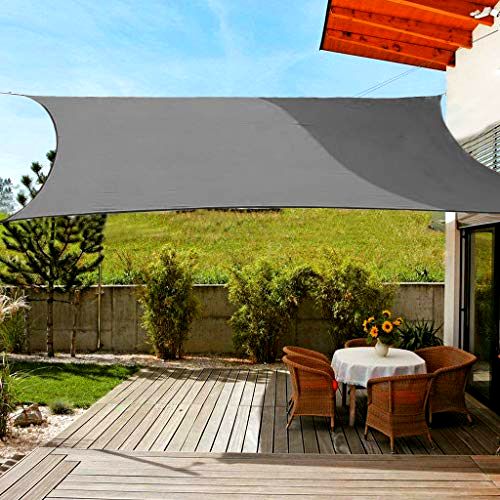
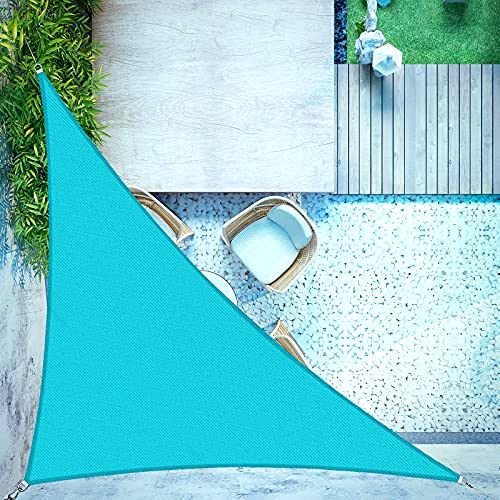
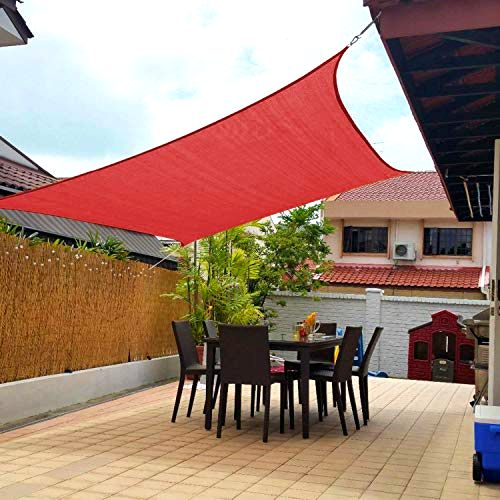
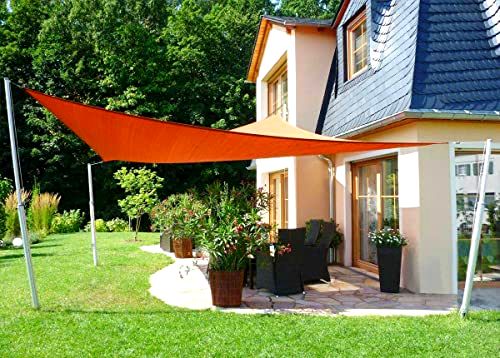
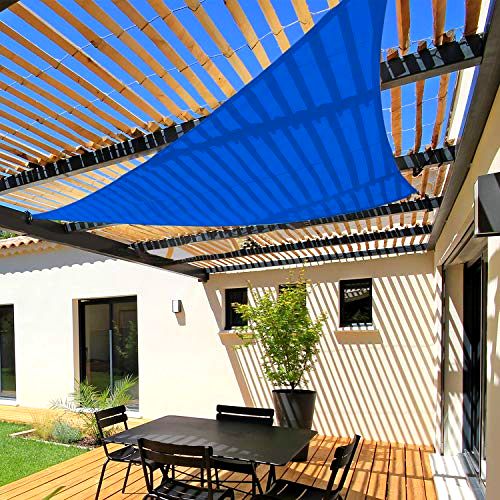
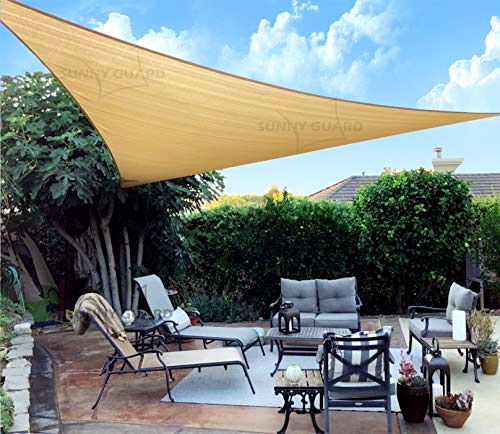
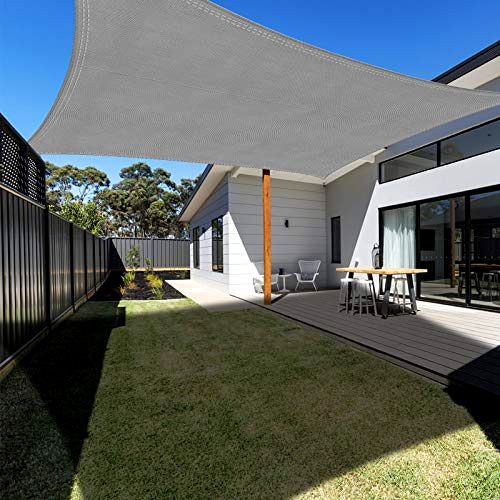
Share